Building a business from scratch is for the brave in today’s digital world. Despite winning over investors, getting your idea approved by dozens of friends and every other member working in your team thinks it is a brilliant idea; however, your business idea is only viable if it is generating a good profit margin.
According to startup statistics and trends for 2023, one-third of startup owners begin their ventures with less than $5,000 without the absolute certainty of success. [1] In 35% of cases, small businesses are not making it up to market because there is no market need for their potential business ideas. [2]
Developing a minimum viable product (MVP) is the most effective way for startups to mitigate this risk inherent in the first year of entrepreneurship. It saves a significant amount of time, resources, and money. Starting from small will help you estimate the end customer demand, and you will never get off the ground by misinterpreting the market need.
In this blog, we’ll explore how to prioritize features for MVP, as it is crucial to understand the minimal set of features required to launch your MVP successfully. We will also walk you through the best insights and sure-shot techniques to prioritize them for future releases. So let’s get started on how to prioritize MVP features!
What is MVP Feature Prioritization?
MVP feature prioritization is a procedure to define and decide the primary features of your MVP. However, you can not prioritize features for MVP spontaneously or based on your intuition. It is an essential step towards developing your MVP, driven by feedback that involves various stakeholders.
Prioritization typically involves thoroughly assessing similar products and their essential features to ensure a viable first release. You need to accomplish all this without spending extra time, effort, and money on adding features that don’t back up your core offering and are likely to evolve in future versions based on user experience and feedback.
Why Does MVP Feature Prioritization Matter
The whole concept of an MVP is to create a basic version of your product that you can put out there and gather feedback from those early adopters.
This feedback is gold because:
- It helps you ensure that your product and its offering are unique
- You can validate your product assumptions quickly and cost-effectively.
- You can test and optimize your product’s aspects, including design, solution architecture, business model, and monetization strategies.
- You can get to the market faster with a profitable product
But here’s the thing: if you don’t prioritize the right features for your MVP, you will end us investing time and resources in things that were not called for. Focusing on the features that solve the problem and bring the most value to your customers is crucial.
How to Prioritize Features For MVP?
To maximize the impact of your MVP, you need to establish a clear vision and development roadmap for your product. Understand the needs and wants of your audience, determine what differentiates your offering and focus on fundamental features that bring value to your users instead of common ones.
Categorize your product’s features into “must-have,” “nice-to-have,” and “optional.” Establish key metrics to monitor performance, such as product quality, customer lifetime value, conversions, and return on investment. Use your MVP to test value proposition, customer segment, and problem solution to test specific hypothesis with assumptions-based metrics.
You can follow these guidelines to prioritize features for MVP:
- Complex designs may not be necessary to demonstrate your core features and can consume valuable time and resources.
- While simple social logins can be included, complex social integrations like feeds or APIs may be better suited for later stages.
- Highly customized user experiences can add complexity but may not be crucial during the initial development phase.
- Promotional materials or additional screens without practical functionality are non-essential content.
This approach allows you to manage your development efforts and budget more efficiently over an extended period. If you want to explore all the relevant criteria related to MVP Development for Startups, then go through this informative piece of content covering everything from how to build an MVP to bent to real-world product examples. You can also consider gaining a technical perspective on your product’s necessary functionalities to make an informed decision.
Steps to Define Features for Your MVP
Making an informed decision on defining a list of minimum viable product features is difficult. Careful feature prioritization for an MVP allows you to decide which ones to include and which to exclude. You can follow these stages for selecting MVP features and iterating based on real-world usage to increase your chances of long-term success.
- Define Your Unique Value Proposition (UVP): Identify features that set you apart from competitors. Showcase these unique features to attract users and make your product stand out.
- Identify Your Target Audience and Their Pain Points: Determine your primary customers, their needs, and how your product can help them. Focus on solving their problems and improving their lives.
- Evaluate Your Competitors: Analyze your competitors’ products and learn from their strengths and weaknesses. Use customer reviews and feedback to gain insights and ideas for improvement.
- Focus On The Needs Met Criteria: Identify the core parts and features indispensable to your product’s existence. Create a list of features and categorize them as “must-haves” and “nice-to-haves.” Prioritize these foundational elements and build upon them.
- Create User Stories: Outline how users interact with your product. These stories should describe the end user’s problem and the actions they need to take to reach their goal. For instance, in the case of an e-commerce website, a user story could be: “As a customer, I want to browse the clothing site, choose an item, and make a purchase.”
- Consider Business Value, Complexity, and Timing: When defining the MVP scope, assess the cost and complexity of each feature and the time required to develop it. Prioritize features based on their impact and feasibility.
- Stay Within Budget: Consider the cost of each feature and exclude those that exceed your budget. Look for alternative solutions or ways to reduce costs without compromising the core functionality.
- Get it Validated from Your End Users: Seek validation from real users and prioritize their problems rather than their feature requests. Focus on delivering value and meeting their needs.
Remember, your product’s success lies in its ability to fulfill users’ needs. Give extra focus on MVP feature prioritization that solve problems, provide value, and iterate and optimize based on feedback.
MVP Feature Prioritization Models
When it comes to categorizing Minimum Viable Product features, there’s no one-size-fits-all rule. However, several approaches and methods exist to prioritize features for MVP effectively. Let’s explore some of the top methods for MVP prioritization:
MVP Prioritization Matrix
This handy method lets you visualize and prioritize features for your product. You rate each feature based on effort, impact, and risk. Then, you divide them into categories such as:
- Must-haves: These are the necessary features without which your product cannot function. They are low-risk and have a significant impact on the core functionality of your app.
- Can-be-done: These features are not as critical as must-haves but can still add value to your app. They are less impactful and may not be essential for the initial release of your MVP.
- Nice-to-haves: They differentiate your product from others in the market. The costs and risks of developing these features may make them unsuitable for the initial MVP but can be included in subsequent versions.
- Waste of Time: These features have both high risks and low impact. They are not essential for the MVP and may divert valuable resources from more critical functionalities.
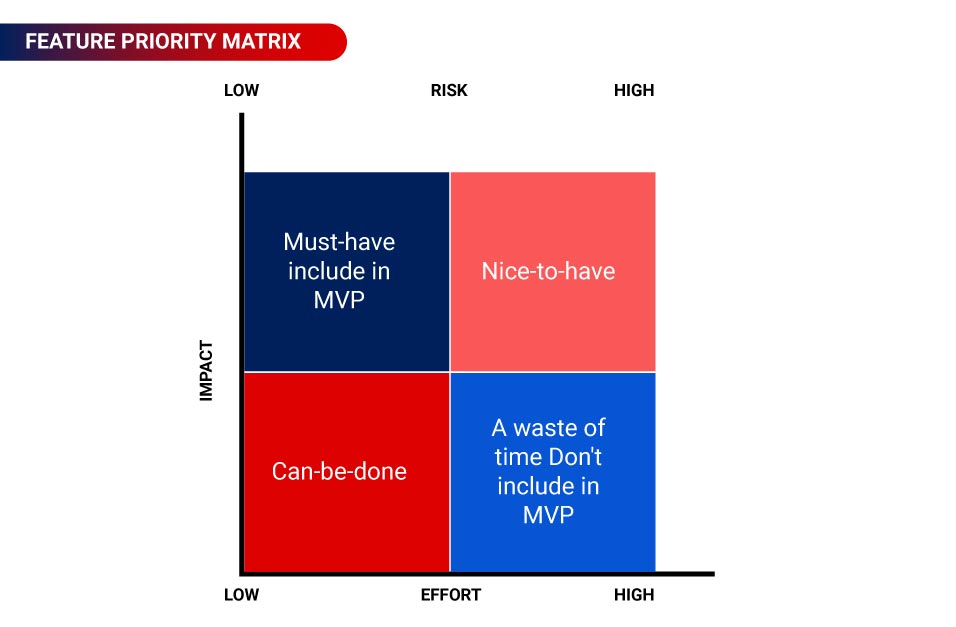
Feature Buckets
This method involves grouping features into different “buckets” based on their types.
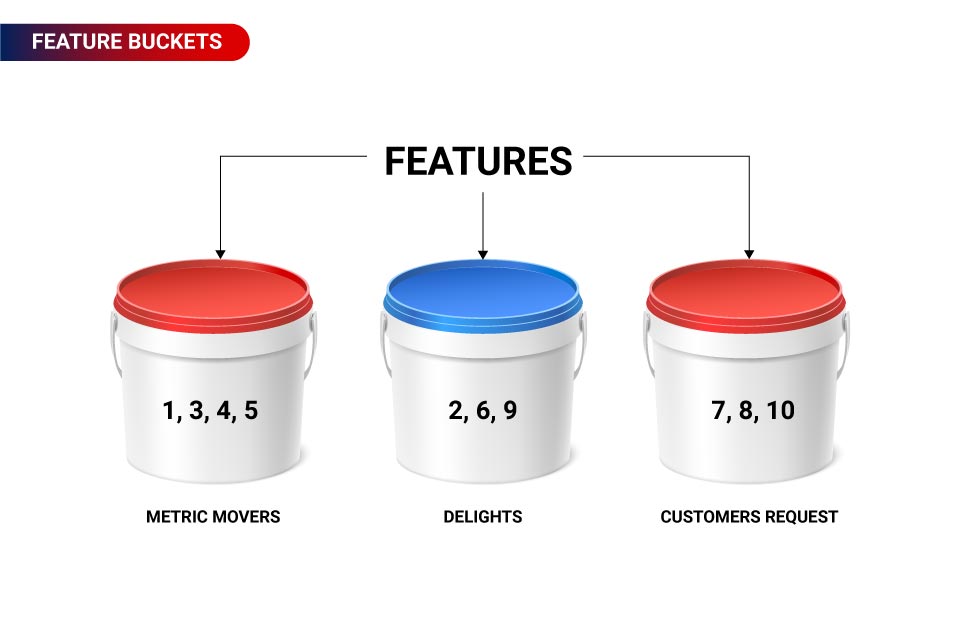
- Customer Requests: These are the features that users have specifically asked for. Pay close attention to the feedback and recommendations from your users, as they provide valuable insights into what they want and need from your app.
- Metric Movers: These features have a significant impact on your app metrics, such as user engagement, customer satisfaction, and income. They are the ones that can drive growth and success for your product.
- Delights: Delights are small yet attractive features that can enhance the user experience and add a touch of uniqueness to your app. These could be things like unique stickers, emojis, or other interactive elements that bring joy and delight to your users.
MosCoW Matrix
This approach helps you strike a balance between delivering a viable product and planning for future enhancements, ensuring that your MVP meets the needs of your users while setting a solid foundation for your app’s growth. It divides features into four subcategories:
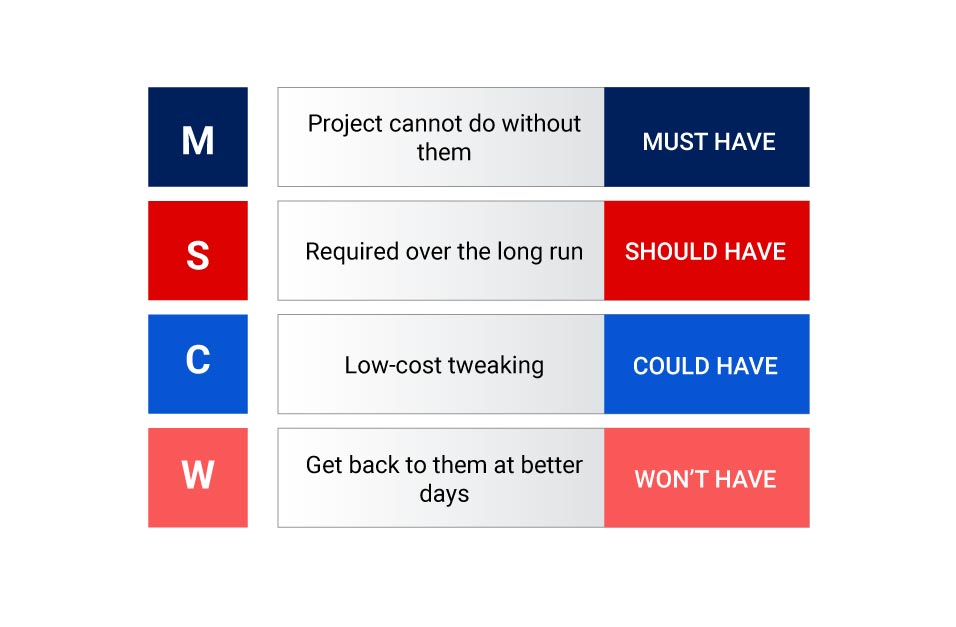
- Must-haves: These are the essential features that form the backbone of your product and make it viable. Without these features, your app wouldn’t be able to fulfill its core purpose or might compromise its security.
- Should-haves: While your MVP can function without them, including these features enhances the user experience and ensures that your product meets the expectations of your target audience.
- Could-haves: These are optional, nice-to-have features that give your MVP a unique personality and set it apart from others in the market. These add-ons provide additional value or enhance the user experience in non-essential ways.
- Not this time: These are the features that you have decided will not be included in your MVP version but are planned for implementation in later iterations or the final version of your app.
Kano Model
One user-oriented approach is the Kano model when prioritizing MVP features. This model focuses on three key attributes to define the MVP features list:
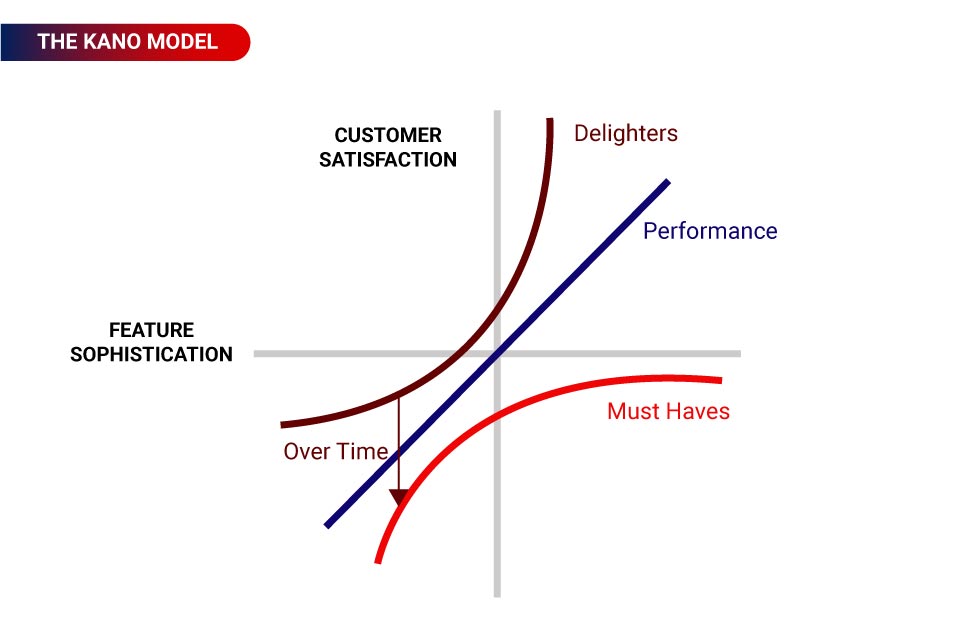
- Threshold: These features are essential for your product to function properly and meet the basic needs of your target audience.
- Performance: Performance features significantly enhance the user experience. They go beyond the basic functionality and provide additional value and convenience.
- Excitement: By incorporating excitement features, you can surprise and engage your users, creating a memorable experience and setting your app apart from competitors.
You must conduct thorough research and customer surveys to apply the Kano model. Based on the findings, you can identify the crucial threshold functionalities for your app’s operability.
Relative Weighting Prioritization
This method considers the benefits of implementing a feature and the potential negative impact of not including it. Several factors are taken into account:
- Benefit: It assesses the positive outcomes and value the feature would bring your product.
- Cost: It considers the resources, time, and effort required to bring the feature to fruition.
- Penalty: It evaluates the potential drawbacks or missed opportunities arising from its absence.
- Risk: It considers any uncertainties or obstacles that may arise during the implementation process.
To calculate the value of each feature, the following formula is used: (Penalty score + Benefit score) / (Risk score + Cost score). Each component is assigned a score of 1 to 9, reflecting its relative importance. You can prioritize the features based on their calculated values, ensuring that the most valuable and impactful ones are included.
Numerical Assignment
Features are categorized as high, moderate, or low priority, with numeric values assigned accordingly.
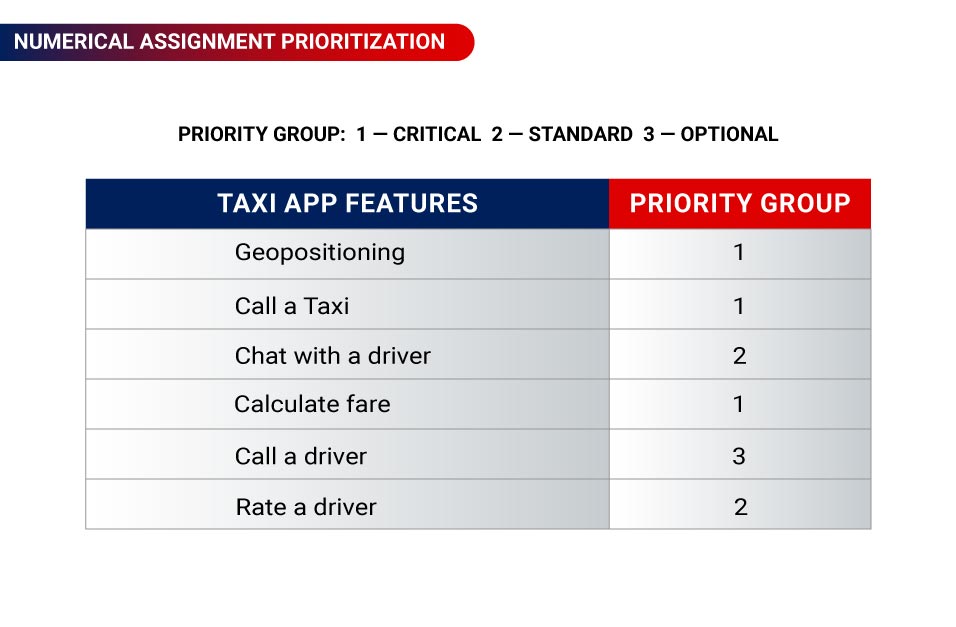
Bubble Sort Method
This method compares functionalities in pairs and iteratively sorts them based on priority. Features with the highest impact rise to the top, like bubbles in a soda drink.
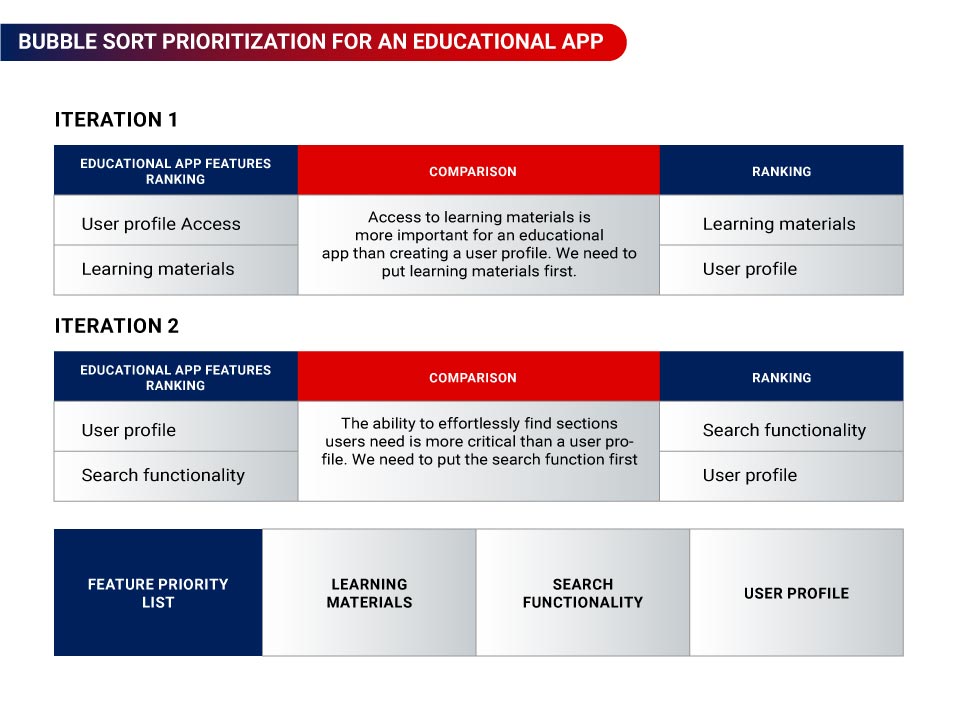
Effort and Impact
This technique assesses feature priorities by evaluating their value and complexity. The correlation between implementation complexity and business value is analyzed, with features categorized as quick wins, major projects, fill-ins, or reconsider.
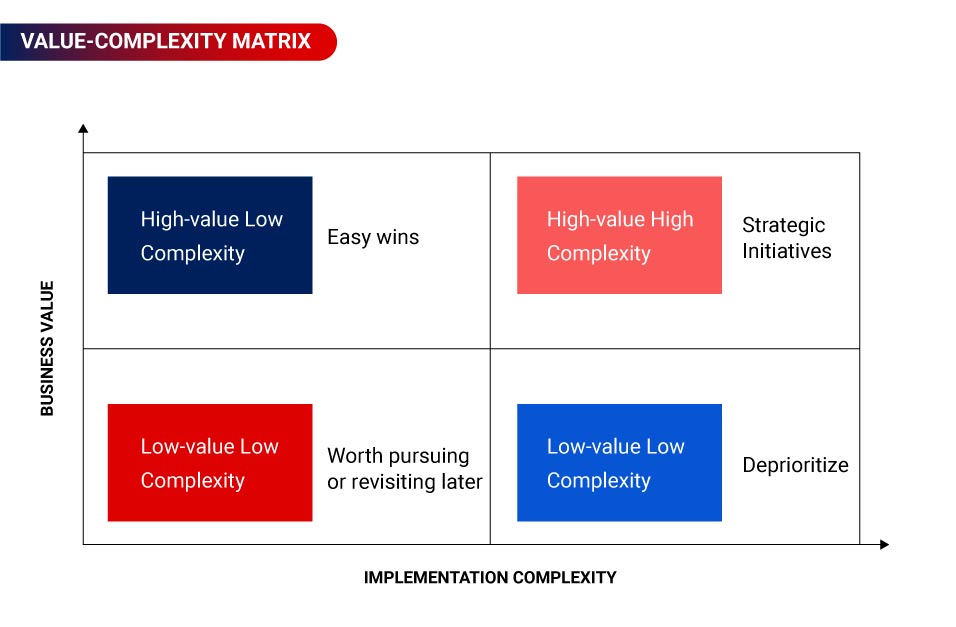
Opportunity Scoring
You can gather feedback on desired features by reaching out to prospective users. Users evaluate existing functionalities in similar apps to determine high and low-impact features.
Speed Boat Technique
This collaborative approach visualizes the development project as a boat navigating a turbulent sea. Features are seen as anchors that hinder or wind in sails that propel the boat toward an MVP release. Brainstorming and feedback are essential in this technique.
User Story Mapping
This popular method involves all stakeholders in the process. Users’ goals are defined, and user stories are created to capture their actions and value. By mapping these stories, you can identify which features are best for the MVP and which ones should be included in future releases.
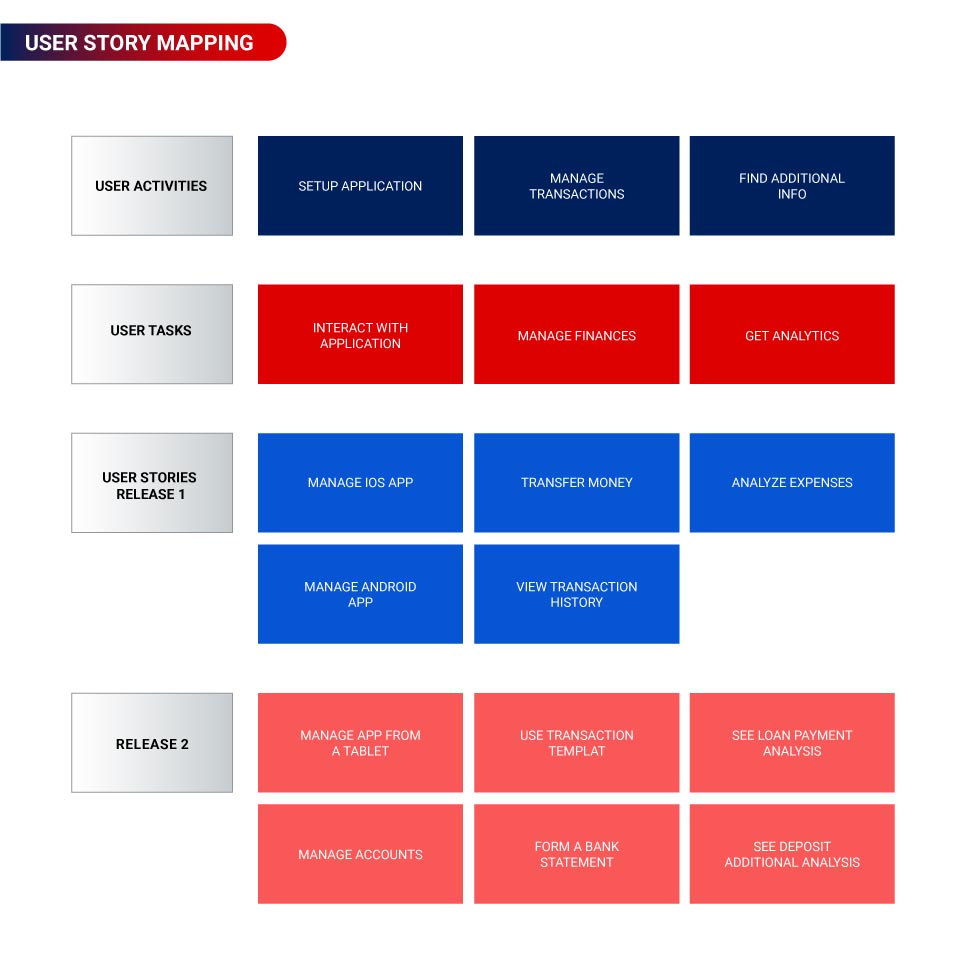
These techniques provide valuable frameworks for prioritizing software features and ensuring your development efforts align with user needs and business goals.
MVP Feature Prioritization: Key Takeaways
There are various methods for MVP feature list prioritization; each has its advantages for different applications. Let me briefly walk you through;
- MoSCoW framework is suitable for smaller teams and budgets.
- Features Priority Matrix helps manage stakeholder relationships.
- Story Mapping provides a big picture of the user journey.
- The Kano Model considers cost versus customer satisfaction.
You can count on us to navigate the intricacies of MVP development while leveraging user feedback and industry best practices, ensuring your product is successful and credible.
How Rishabh Software Can Help You Build Successful MVP?
We discussed sure-shot techniques and methods to prioritize features for MVP; however, you are not required to apply all of them together to get the job done. Every MVP is different, and prioritization metrics have no golden rule. Market validation should be the end goal of your MVP. All you are required to do is give your end users priority and don’t be afraid to gather additional feedback and make required adjustments to your MVP.
At Rishabh, we have helped several startup founders build successful products that have helped them achieve millions in funding and product users. Our in-depth knowledge and extensive experience with founders and entrepreneurs have helped us to understand business and market needs to contribute to successful MVP development. Leverage our software product development services to build a successful MVP and set yourself up for success.
FAQs
Q: How many features should an average MVP have?
A: When determining the number of features for an average MVP, there isn’t a one-size-fits-all answer. You must strike the right balance between providing enough functionality to engage users and keeping the scope manageable.
At Rishabh Software, we work closely with our clients to understand their specific requirements and target audience. Through careful analysis and market research, we identify the core features that will deliver the most value and create a compelling user experience for your MVP.
Q: What is a single-feature MVP?
A: Imagine launching a product with just one superpower—a single feature that sets it apart. This ingenious concept stems from the Lean Startup methodology, where speed and validation are critical. By focusing on one core feature, you can swiftly create a stripped-down version of your product and get it out in the market. You can make data-driven decisions with feedback and ensure your product evolves into something that truly delights your customers.
Q: Should all features in an MVP be fully developed, or can some be implemented as prototypes?
A: In the MVP development process, all features don’t need to be fully developed from the start. Implementing some features as prototypes can be a smart strategy. We can help you identify which features are critical for the initial launch and should be fully developed, while others can be presented as prototypes or minimum viable versions. This approach allows you to gather valuable user feedback early on and make informed decisions about the direction of your product, saving time and resources in the process.
Q: How do you balance scalability and resource optimization when choosing MVP features?
A: Balancing scalability and resource optimization is a crucial consideration when selecting MVP features. We ensure that your MVP needs are functional and scalable for future growth. Our experienced development team evaluates each feature’s potential impact and technical feasibility, considering factors such as development complexity, timeframes, and available resources. We carefully prioritize and select features that provide the most value with optimized resource allocation.
Q: Can MVP features be adjusted based on early user adoption and feedback?
A: Yes! One of the key advantages of an MVP is its iterative nature, allowing for adjustments based on early user adoption and feedback. By incorporating feedback loops and analytics tools, you can monitor user behavior and preferences to refine and adjust the MVP features as needed. This iterative approach ensures that your product evolves in alignment with user expectations, increasing its chances of success in the market.
Footnotes:
1. https://www.embroker.com/blog/startup-statistics/
2. https://www.oberlo.com/blog/small-business-statistics











 30 Min
30 Min


